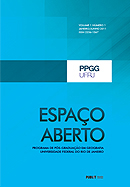Digital Mapping of Fe2O3, MnO, Nb and TiO2 Contents in Morro Seis Lagos – AM, Brazil
DOI:
https://doi.org/10.36403/espacoaberto.2024.60234Keywords:
Pedometrics, Machine LearningAbstract
Concepts in pedometrics and Machine Learning techniques are increasingly used in the execution of soil surveys, employing digital soil mapping procedures. The objective of the study was to evaluate the performance of Multivariate Adaptive Regression Spline (MARS), Radial Support Vector Machine (SVMRadial) and Random Forest (RF) models, for spatial prediction of Fe2O3 , MnO, Nb and TiO2 , in the Morro dos Seis Lagos-AM, Brazil.The methodology consisted of: Thematic review; Compilation of geochemical data; Treatment and analysis of data (input data); Selection of covariates; Application of algorithms for prediction of elements; obtaining the maps, analysis of results and interpretations.The results showed greater accuracy for the prediction of iron oxide (Fe2O3), manganese (MnO) and niobium (Nb) contents, with the RF model, while for titanium (TiO2), better performance was observed with the SVMRadial model. Morphometric covariates were more relevant than covariates derived from spectral indices.
Downloads
Downloads
Published
How to Cite
Issue
Section
License
Copyright (c) 2024 Niriele Bruno Rodrigues, Júlio Cesar Lopes da Silva, Renan Pereira Marinatti da Silva, Helena Saraiva Koenow Pinheiro, Waldir de Carvalho Júnior

This work is licensed under a Creative Commons Attribution-NonCommercial-ShareAlike 4.0 International License.



